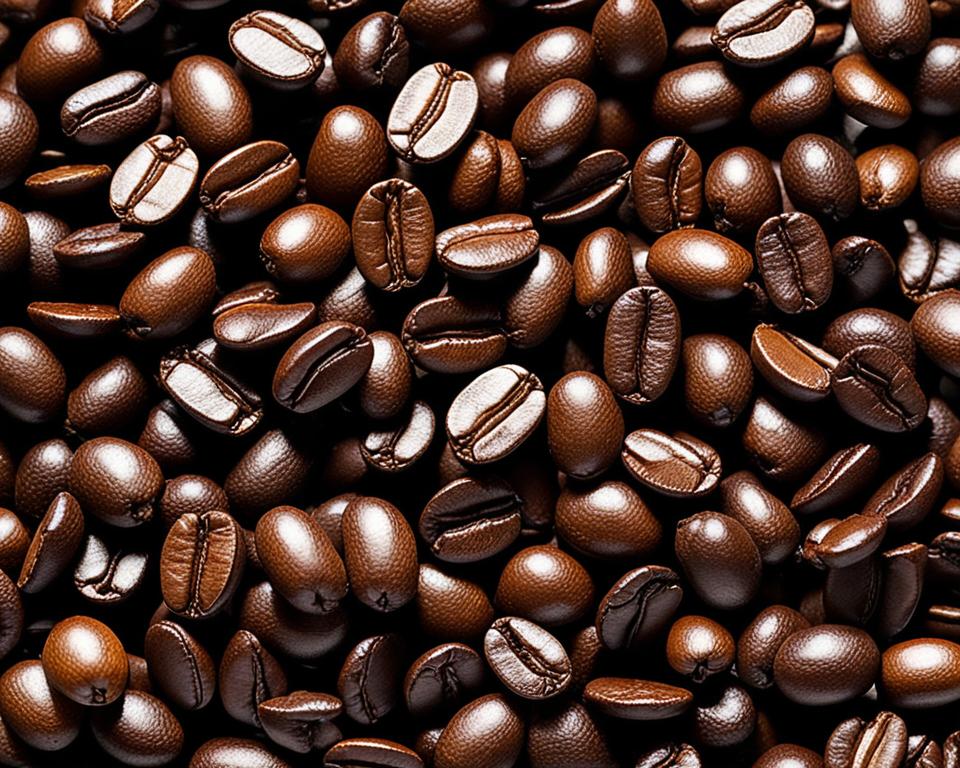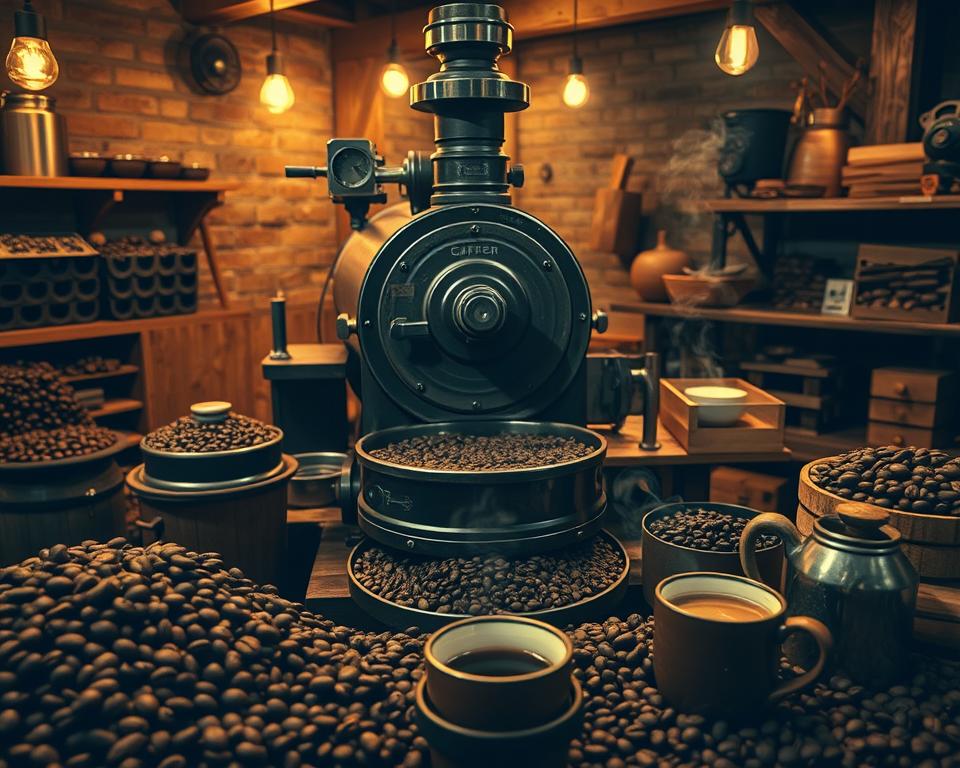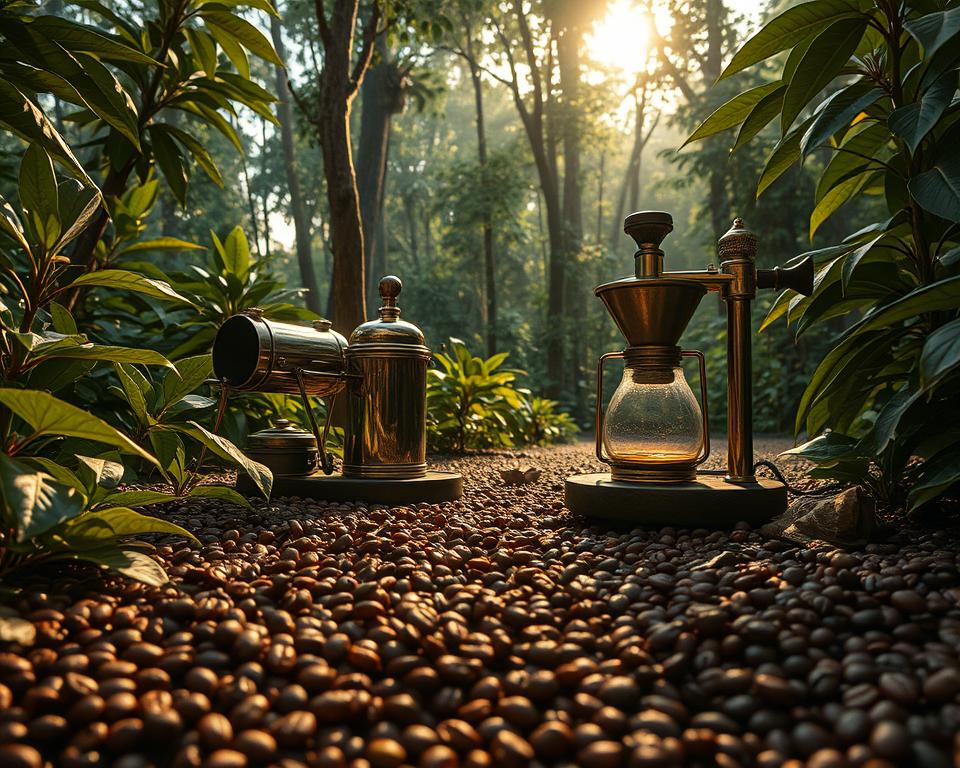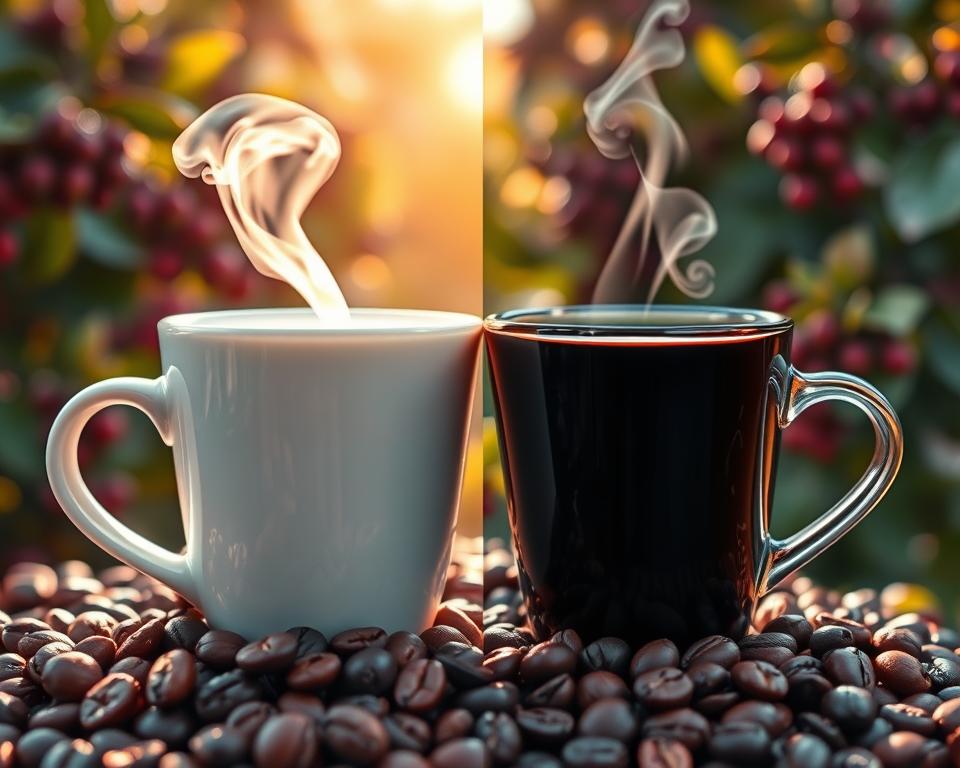- Imagine this: nearly every coffee cup worldwide originates from two beans—Arabica vs. Robusta. These beans are crucial to the coffee industry, making up about 99% of its production. My exploration of these beans introduced me to a world of competing flavors. Arabica, known for its sweet taste, makes up 60–70% of global coffee.Robusta, on the other hand, is more bitter and contains more caffeine, accounting for 30–40%. This raises a question: if these beans face challenges like the banana industry did, could coffee be at risk too?
As I enjoy Arabica’s fruity and chocolatey notes and prepare for Robusta’s strong taste, I think about market and climate issues. Robusta could be key to overcoming challenges as warming climates threaten Arabica’s production in places like Ethiopia.
These situations add another layer to my coffee experience, blending economy, ecology, and human stories into each sip.
Let’s explore the unique qualities of Arabica and Robusta. They do more than just cater to different tastes—they symbolise the global coffee market’s future challenges and possibilities.
Key Takeaways
- Arabica coffee, with its sweet flavours and aromatic depths, dominates global coffee production but faces threats from climate change.
- Robusta coffee, known for its high caffeine content and robust strength, could become increasingly vital as growing conditions change.
- The worldwide coffee market is highly sensitive to climate factors, as seen in the price hikes following weather adversities in Brazil.
- Despite the prevalence of Arabica and Robusta, hundreds of coffee varieties exist, each with unique traits and flavours.
- Lesser-known beans like Liberica are poised to become important players in coffee’s resilient and diverse future.
Introduction to the Coffee Titans
In the world of coffee, two giants stand out: Arabica and Robusta. These two kinds of coffee are very different, starting with where they come from. About 65% of the coffee made worldwide is Arabica, which comes from Ethiopia and South Sudan.
Robusta beans, on the other hand, come from the rainforests of West Africa. They are tougher plants. Arabica beans grow in cool, high areas like Colombia’s mountains, which are between 1,200 and 1,800 metres high. Robusta beans like it warmer and can grow in lower places.
Discovering Arabica and Robusta
In the UK, people drink about 85 million cups of coffee every day. When I looked more into Arabica and Robusta, I found out Ethiopia exports a lot of Arabica, worth around $1 billion a year.
Arabica grows in high places where there is a lot of rain, which gives it a special taste. It can taste fruity, like citrus, or even like chocolate. This is why it’s often used in fancy coffees.
However, wild Arabica coffee is at risk because of things like climate change. Also, Arabica has less caffeine than Robusta, so it’s not as strong.
The Cultural Impact of Coffee Varietals
The differences between Arabica and Robusta are not just about where they grow or their taste. They also affect culture. Arabica’s unique flavours make it popular in the specialty coffee scene.
Robusta’s stronger taste and more caffeine meet the needs of people who like their coffee powerful.
Understanding these coffees involves looking at how high Arabica grows, how they’re processed, and their complex smells.
| Characteristic | Arabica | Robusta |
|---|---|---|
| Native Region | Ethiopia, South Sudan | West Africa |
| Global Production Share | Approx. 65% | Remainder of total production |
| Altitude of Cultivation | 500 – 2,000 meters | Generally lower than Arabic |
| Flavor Notes | Fruity, floral, citrus, and chocolate | Strong, robust |
| Caffeine Content | Lower (e.g., 0.76 mg/g) | Higher (Typically 12 mg/g) |
| Status | Endangered (IUCN Red List) | Not classified as endangered |
To sum it up, Arabica and Robusta coffees represent more than just drinks. They reflect a blend of culture, environment, and taste that influences our daily lives and connects us to places far away.
Distinguishing Arabica and Robusta Beans
Exploring Arabica vs Robusta taste reveals their unique growing conditions and chemistry. As a coffee lover, I see how these differences impact my choice of coffee and enjoyment.
They play a big role in the taste of my brew.
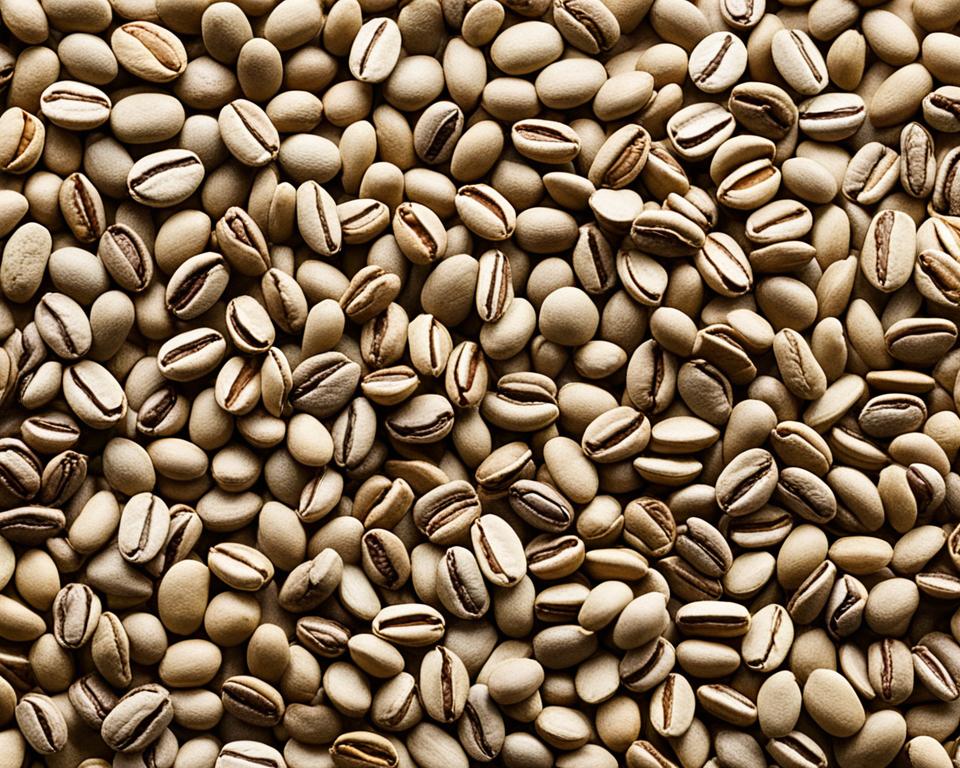
Arabica beans make up 60% of the world’s coffee. They grow best in high places, over 3,000 feet, where the climate is cooler. Arabica’s taste is rich and varied. You might sense flavours like floral, citrus, spice, or chocolate. This variety comes from its high sugar and lipid levels.
Robusta beans, on the other hand, are packed with caffeine, almost twice as much as Arabica. This gives them a stronger, sometimes bitter taste. Yet they’re key to a perfect crema on an espresso.
They often taste nutty or chocolaty. Blenders mix Arabica and Robusta to create different flavour profiles, catering to local preferences.
Robusta is also tougher than Arabica. It can grow in many more places, both subtropical and tropical. It’s full of chlorogenic acids and beneficial antioxidants.
Because of this, it has a bold taste that coffee fans love.
- Arabica’s smooth, diverse flavour profiles lend themselves well to those who prefer subtlety.
- Robusta’s robust caffeine punch caters to those seeking bold, energising brews.
- Ultimately, blending both Arabica and Robusta beans strikes a harmonious chord that resonates across the global coffee scene.
The Global Journey of Coffee Beans
Exploring the world of coffee reveals the unique tales of Arabica coffee and Robusta coffee. Arabica is steeped in tradition, while Robusta presents a bold path. Each has its own unique journey.
Arabica’s Ethiopian Roots and Widespread Growth
The tale of Arabica coffee starts in Ethiopia, with goats discovering its invigorating effects. This discovery has led Arabica coffee to become a major player, making up 70% of the world’s coffee.
The beloved taste of Arabica coffee is now a main part of coffee culture in countries like Brazil, Colombia, and Costa Rica.
Robusta’s Emergence and Dominion in the East
Robusta coffee has made a strong name for itself, especially in Africa, Southeast Asia, and Brazil. It now represents about 30% of the world’s coffee.
With its bold flavour and high caffeine content, Robusta stands out in stronger blends.
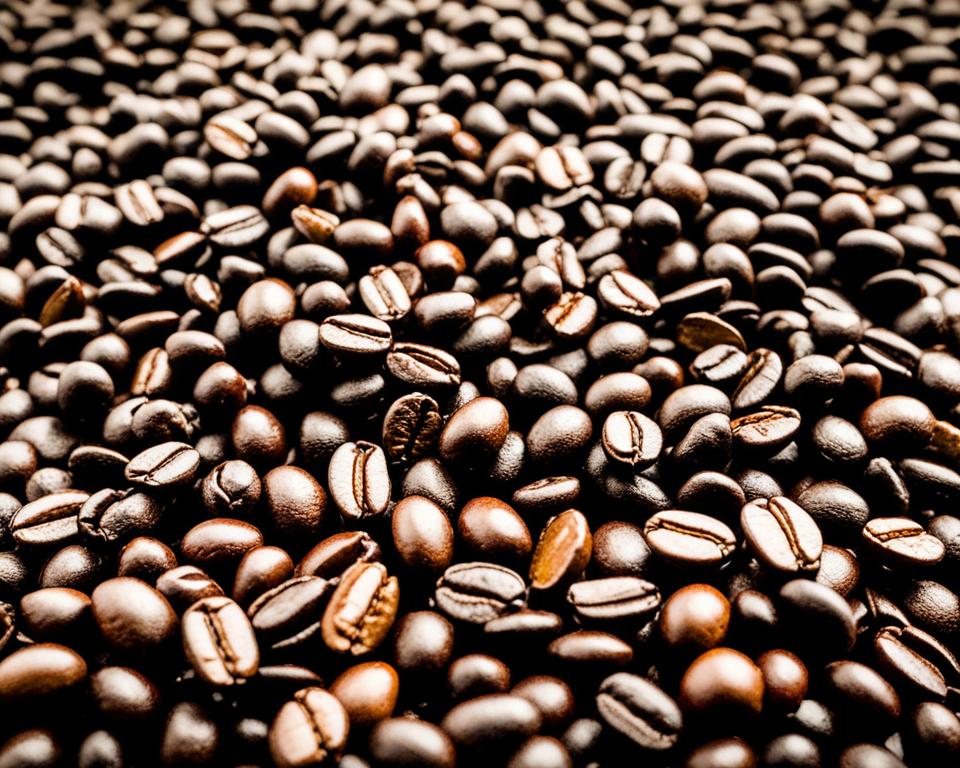
| Aspect | Arabica Coffee | Robusta Coffee |
|---|---|---|
| Global Production Share | ~70% | ~30% |
| Cultivation Altitude | 2,000 to 6,000 feet | Can grow at lower altitudes |
| Average Yield per Plant | 1 pound of beans | 1 pound of beans |
| Key Producing Countries | Brazil, Colombia, and Ethiopia | Vietnam, Indonesia, and Brazil |
| Bean Caffeine Content | Less | 50-60% more |
| Roasting Time | 7-14 minutes | 7-14 minutes |
In exploring these beans, I’ve seen their impact on culture and the economy. Coffee is more than just a drink. It reflects the hard work of many people. From the Arabic beans in foggy highlands to Robusta on large farms, it’s central to daily life and connects us globally.
Arabica vs. Robusta Taste Showdown
In the Arabica vs. Robusta flavour comparison, both coffee types have unique tastes. Arabica is famous for its smooth, sweet taste, with hints of chocolate and fruit. It has less Arabica vs. Robusta acidity.
On the other hand, Robusta packs a strong, earthy flavour with a bitter edge due to more caffeine. These taste differences come from their chemical make-up and where they grow.
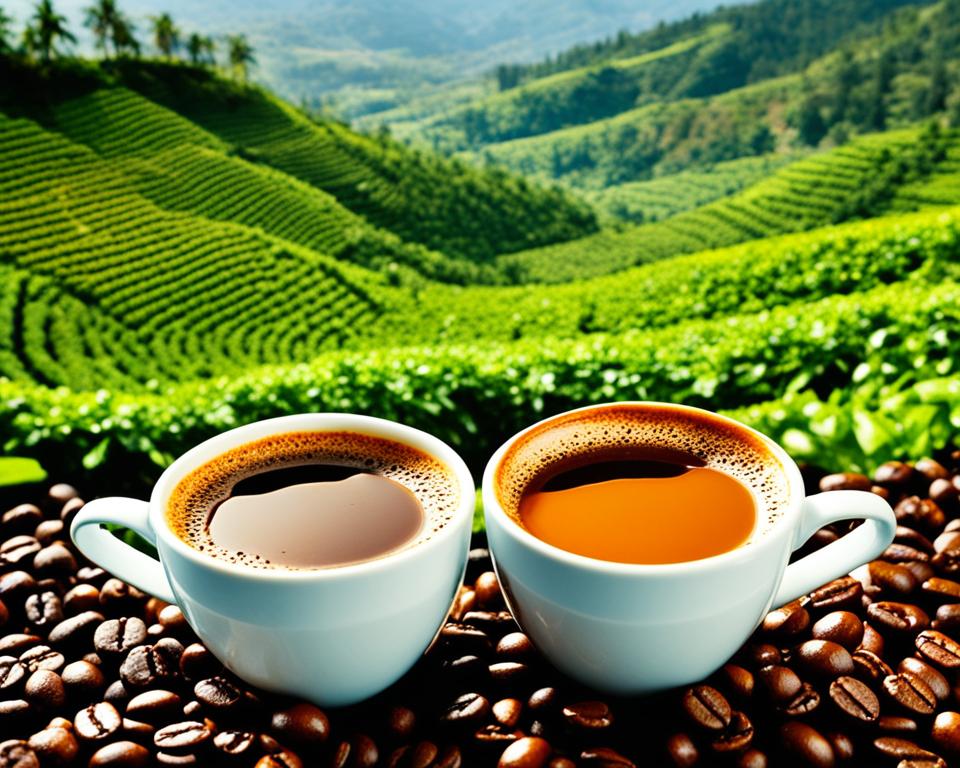
Arabica beans lead global coffee production, but robust, bold Robusta stands its ground. Together, they make up 99 percent of the world’s coffee market. Recent price jumps, especially with Brazil’s climate issues, impact both Arabica and Robusta.
These shifts recall when bananas switched types due to disease, mirroring coffee’s history with the move from Liberica to other varieties because of disease outbreaks.
In Ethiopia, Arabica coffee’s birthplace, climate change threatens up to 59 percent of its coffee-growing lands. Meanwhile, a tougher Robusta may become a good alternative.
Despite these challenges, interest in other coffee species, like Liberica, is growing, pointing to new possibilities for coffee culture and climate adaptation.
- Arabica’s acidity amplifies its flavours, making it suitable for those preferring a milder buzz.
- Robusta’s lower acidity and bold taste cater to those desiring a stronger caffeine punch.
- Liberica provides unique flavours, reflecting its historical prominence and newfound attention.
Exploring these flavours means more than just taste—sustainability, climate resilience, and economic viability matter too. They influence the future of our favourite coffee.
Understanding Caffeine: Arabica vs. Robusta
Choosing the perfect cup of coffee means understanding Arabica and Robusta beans. The type of bean affects not just the taste but also how awake I feel.
Arabica beans are milder and aromatic, with about 1.5% caffeine. This is great for starting my day without feeling too jittery. Robusta beans, however, have a higher caffeine content of 2.7%. They give a strong wake-up call for those who need it.
Navigating Caffeine Content in Your Cup
Looking at Arabica and Robusta, we see different caffeine impacts. Arabica beans offer a sweeter, gentler caffeine hit. Robusta packs a punch, which is great on sleepy mornings.
The choice influences not only our energy but also the taste of our coffee. It’s about finding the perfect balance or intensity for our liking.
The Influence of Caffeine on Flavor and Perception
Arabica and Robusta beans differ more than caffeine. They bring unique flavours to our cups. Those seeking depth will love Arabica’s nuanced tastes.
If you prefer bold and bitter, Robusta could be your choice. Choosing the right bean makes my coffee experience ideal, whether I want to relax or get energised.
| Aspect | Arabica | Robusta |
|---|---|---|
| Caffeine Content | 1.5% | 2.7% |
| Flavor Profile | Sweeter, more aromatic | Bolder, more bitter |
| Best For | Those seeking a gentle buzz | Those needing a strong boost |
| Coffee Volatiles | Less variability post-roast | More variability post-roast |
How Does Arabica Coffee Compare to Robusta in Terms of Flavor and Quality?
When it comes to flavor and quality, Arabica coffee is often preferred for its smooth, nuanced taste and lower acidity. In contrast, Robusta tends to be stronger, with a more bitter profile. For those interested in flavor nuances, comparing arabica and liberica coffee varieties explained reveals even more distinctions in taste and aroma.
Conclusion
Reflecting on the flavour dance between Arabica and Robusta beans, we see how our taste shapes our choice. If you love a softer taste with less caffeine, you might prefer the Arabica vs. Robusta blend.
A strong cup of Robusta is perfect to kick-start my day due to its bold caffeine boost. These beans offer a broad range of flavours for coffee lovers like us.
The exploration of coffee types led me to study their health impacts. Interestingly, research shows drinking coffee could reduce the risk of type 2 diabetes.
This is according to a study in Nutritional Reviews. Such insights make our coffee drinking more meaningful, beyond just the taste.
Whether you’re exploring the aromatic Arabica vs. Robusta blend taste or prefer the straightforward Robusta, every sip is more than flavor. It’s a blend of health benefits and personal discovery.
With each cup, we embark on a journey of taste, health, and self-exploration that keeps evolving.
FAQ
What are the primary differences between Arabica and Robusta coffee?
Arabica coffee is loved for its smooth, sweet taste. It has hints of citrus and chocolate. Robusta coffee is stronger and more bitter, with an earthy or nutty flavor. Arabica beans are larger, sweeter, and contain less caffeine than Robusta beans, which have nearly double the caffeine.
Where do Arabica and Robusta coffee beans originate from?
Arabica coffee began in Ethiopia. It is now grown mostly in Latin America and Africa. Robusta started in the rainforests of West Africa. Today, it’s largely cultivated in Vietnam, Indonesia, and India.
How does the caffeine content compare in Arabica vs. Robusta coffee?
Robusta coffee has about 2.7% caffeine, roughly twice that of Arabica’s 1.5%. This makes Robusta’s taste stronger and more bitter compared to Arabica’s smoother flavour.
Can you describe the cultivation conditions preferred by Arabica and Robusta coffee plants?
Arabica plants like cooler climates and high places, from 600 to 2,200 meters. Robusta prefers heat and does well in low areas, often below 600 meters. Arabica is more prone to pests and diseases than the tougher Robusta plant.
What flavour profiles can be expected from Arabica and Robusta coffees?
Arabica coffee has a wide range of tastes. You might notice floral, fruity, and sweet notes with some acidity. Robusta coffee is stronger with a full-bodied feel, giving off nutty, grainy, or earthy flavours with less acidity.
Why is Arabica coffee generally considered superior to Robusta?
People often see Arabica as better because of its complex, flavorful, and less bitter taste. Arabica’s smooth taste wins over those wanting a refined coffee experience. But what’s “better” really depends on your own taste.
What are the benefits of a blend of Arabica and Robusta beans?
A mix of Arabica and Robusta beans means you get both of their special qualities. You get Arabica’s smooth, complex taste with Robusta’s strong, rich kick. This blend appeals to many coffee lovers, offering a fuller flavour experience.
How does the acidity of Arabica compare to that of Robusta?
Arabica beans are more acidic than Robusta beans. This adds a bright, wine-like taste to Arabica coffee, making it more complex. Robusta has less acidity, leading to a heavier, bitterer taste with a stronger body.
Is the higher caffeine content of Robusta noticeable in taste?
Yes, Robusta’s higher caffeine makes its taste stronger and more bitter. This bitterness, linked to more caffeine, can be easily tasted. It’s especially clear when compared to Arabica’s milder flavour.
Are Arabica or Robusta beans better for espresso?
Choosing Arabica or Robusta beans for espresso is all about what you like. Arabica offers a smooth, nuanced shot with nice acidity. Robusta makes for a bolder, creamier shot. Some people blend them for espresso, getting complexity and depth.

